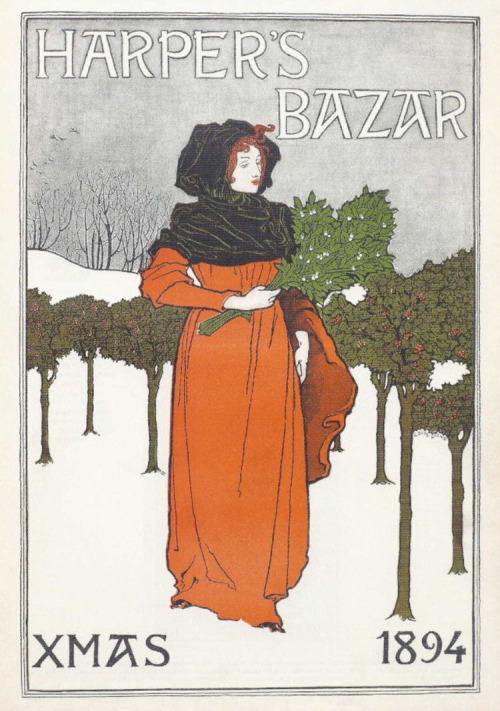The holiday has been put away. The wreath is turning brown. Town Christmas tree pick-up began last week. It is time to head to the Met to buy next year’s cards at half-price in the museum store.
The general run of contemporary Christmas mailings ranks low on any measure of cultural exchange. It is not nostalgia that sends me hunting for cards with older images. It is the clear, transparent fact that the graphics of a previous generation addressed themselves to the eye—and the spirit—with an intelligence that is fast disappearing from our sensibilities. I try to honor it—reclaim it?— however I can.
How long has it been since you looked forward to opening Christmas cards? Have you stopped hanging them from string, pinning them to red ribbons, or tucking them into branches of your Christmas tree?
For me it has been some while since I even stood them up on a shelf. Interest waned, receding gradually but as surely as the tide along the Hudson. It is impossible to pin the beginning of disenchantment on a specific year. I just know that the dwindling down has something to do with the ramping up of that self-admiring phenomenon, the Christmas Letter.
It is a ghastly genre. Little of it counts as a greeting. Nine-tenths of it is full-throated boasting thinly disguised by strenuous effort to sound breezy and casual. Nonchalance is hard to feign while you tally up a year’s worth of triumphs and acquisitions. But self-advertisement is the keynote of our Facebook age.
O Come, All Ye Braggers
The annual dispatch opens by listing the clever people your friends visited during their marvelous visit to Oxford and on up to London. (Or was it the anniversary trip to Bermuda? The bachelor party in Cancún?) And that was just the winter. In spring, the whole family took this year’s annual outing in the Monteverde Cloud Forest Reserve. (Costa Rica is sooo much better than Orlando! You really must go.) Summer brought the clan back to Nantucket and the time-share on Brant Point.
The hotdogging carries forward: Kevin won an award for the most straight A’s in middle school; Penny’s braces came off and she won two swimming trophies; Ellie sings solo in the parish choir and is headed for Princeton next fall. Yours Truly just received a spectacular promotion and soon will be racking up air miles to Silicon Valley. (Or is it D.C, Cambridge, or Rome?) In a sunny, insouciant way, your epistler lets on that Connie is one of the top realtors in Upscale County. And, oh, before anyone forgets, the family’s beloved Portuguese water dog earned a best-of-show ribbon in the Purina Follies.
In all, it has been a splendid year for us. So there!
Some of these things arrive simply typed on computer paper; some use a commercial template. No matter. Details differ from sender to sender but the gestalt remains the same.
Politics crept in this year. Several communiqués included unhappy noises over “what has befallen us” electorally speaking. In the end, though, there is only one Christmas Letter. Year after year it gets passed from one household to the next. Just like that Harry & David fruitcake that Aunt Kitty sent you last year and you delivered to the Tomasulos next door as a New Year’s present.
Then Comes the Selfie Card
The Card follows suit. By the second week in December, The Card begins to arrive from different people who seem not to notice that they are sending the same Card as everyone else. You know the one. It is that postcard with the color photo of the family—often just the kids, but always with the family canine if there is one.

The Sheehans are in snorkeling gear; the Martins are in ski goggles. All Donaldsons pose on the roof of a jeep with a Sonoma landscape in the background. The Zangretti kids mug for the camera at the base of you-know-whose statue in Trafalgar Square. The Gallaghers take a selfie in front of the Mona Lisa to let us know they hit the Louvre this year.
Often as not, the signature is pre-printed: LOVE, Lizzie, Steve, Vinnie, Amy, & Mary Frances. Sometimes, XXOO is added in ballpoint to personalize the thing. Why bother? It is still a mechanical gesture—perhaps not totally discardable but near enough. No sendee needs to open the envelope to see what is inside. We already know. It’s The Card. And without opening it we know who sent it. The sender’s name is right there on the return address.

This year, for the first time, I found myself ditching The Card unopened. In the spirit of “making a list, checking it twice,” I noted the name in the upper left corner of the envelope, checked it against my own list, then threw it out.
For me, the pleasure of Christmas cards has been—I confess—inseparable from the image. It does not have to be religious, though that suits the feast day best. But it does have to be beautiful, have some charm to it. It should have a graphic grace that makes it worth looking at. Photos are fine, but only if they are inserted by hand into the fold of a card that honors what is distinct and lovely in the day. A day that waits for recognition of its absolute independence from ourselves and from what we have made of the past year.
We have months and a wealth of ways to tell about our doings and send pictures of our own children. Email, Instagram, Facebook—the whole constellation of social media exists for show-and-tell. Christmas commemorates a single family and celebrates the birth of one child only. It puzzles me how even religious-minded people gladly substitute pictures of their own children and grandchildren for the one in the manger. Yet it is that one, the only One, Who gives meaning to our children’s lives and signals their ultimate destiny.
Besides, The Card is unsightly—almost invariably garish, cluttered, flat as a parking ticket. In the end, that is sacrilege enough.

This time last year Studio Matters took a tour through commercial Christmas cards of an earlier generation:
Their graphic intelligence—linear and compositional elegance, or what the old Italians called disegno—displays sensibilities that are rarely matched anymore in standard seasonal illustration. In part, that is because Christmas is no longer a spur, commercial or personal, to high imaginations. Talent drifts elsewhere. Also, grace of hand, long in developing, has given way to drawing software and to the photograph. An electronic mouse does not have the conscience of a trained hand. And a camera makes image production quicker and more facile than the mind’s eye—an organ which sees through the soul, unaided by a mechanical lens, unhurried by an impatient shutter.
. . . It is against the artistry and refinement of these non-religious images, made for a popular audience, that we can measure more vividly the diminuendo of Christmas in the larger culture.







